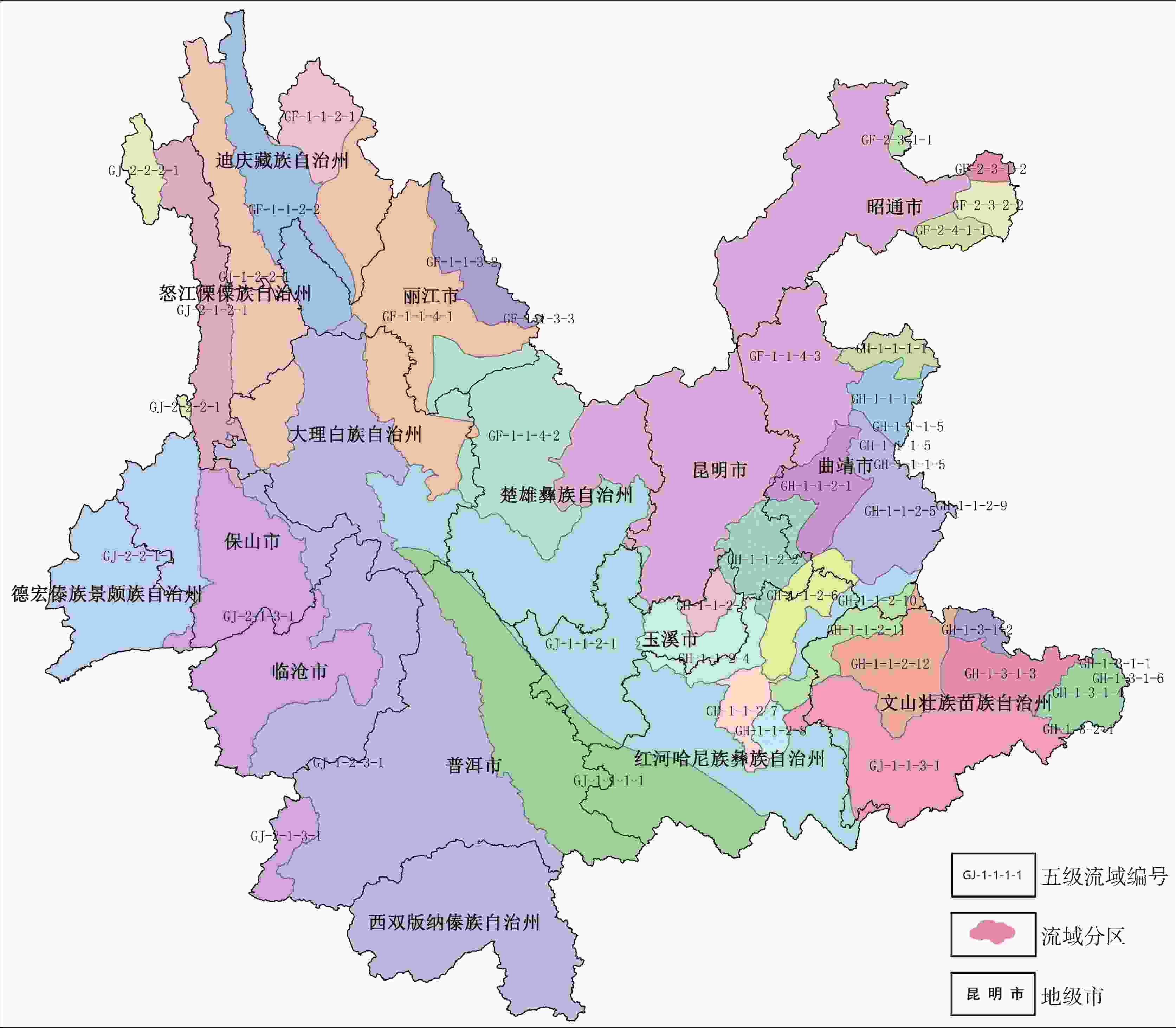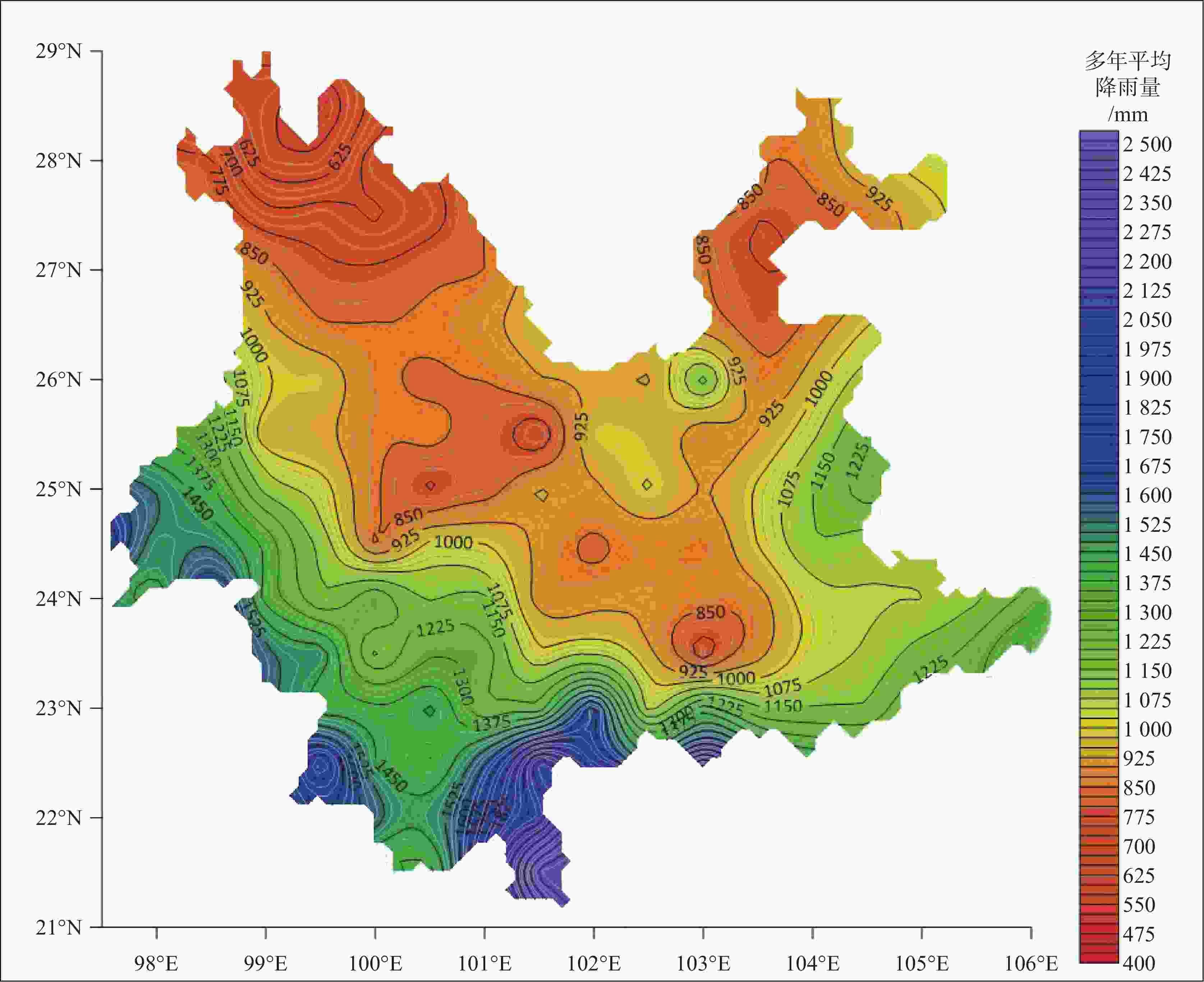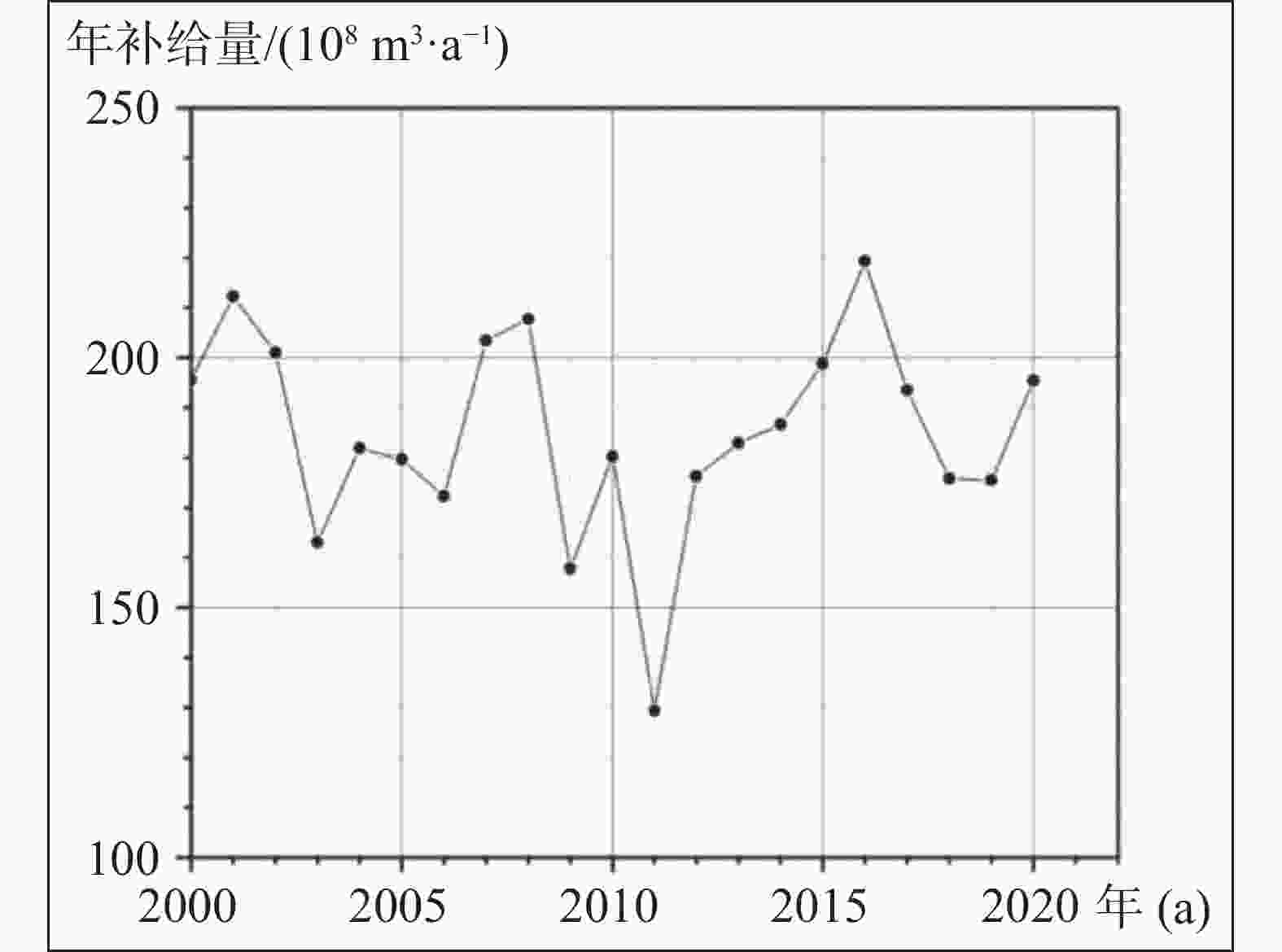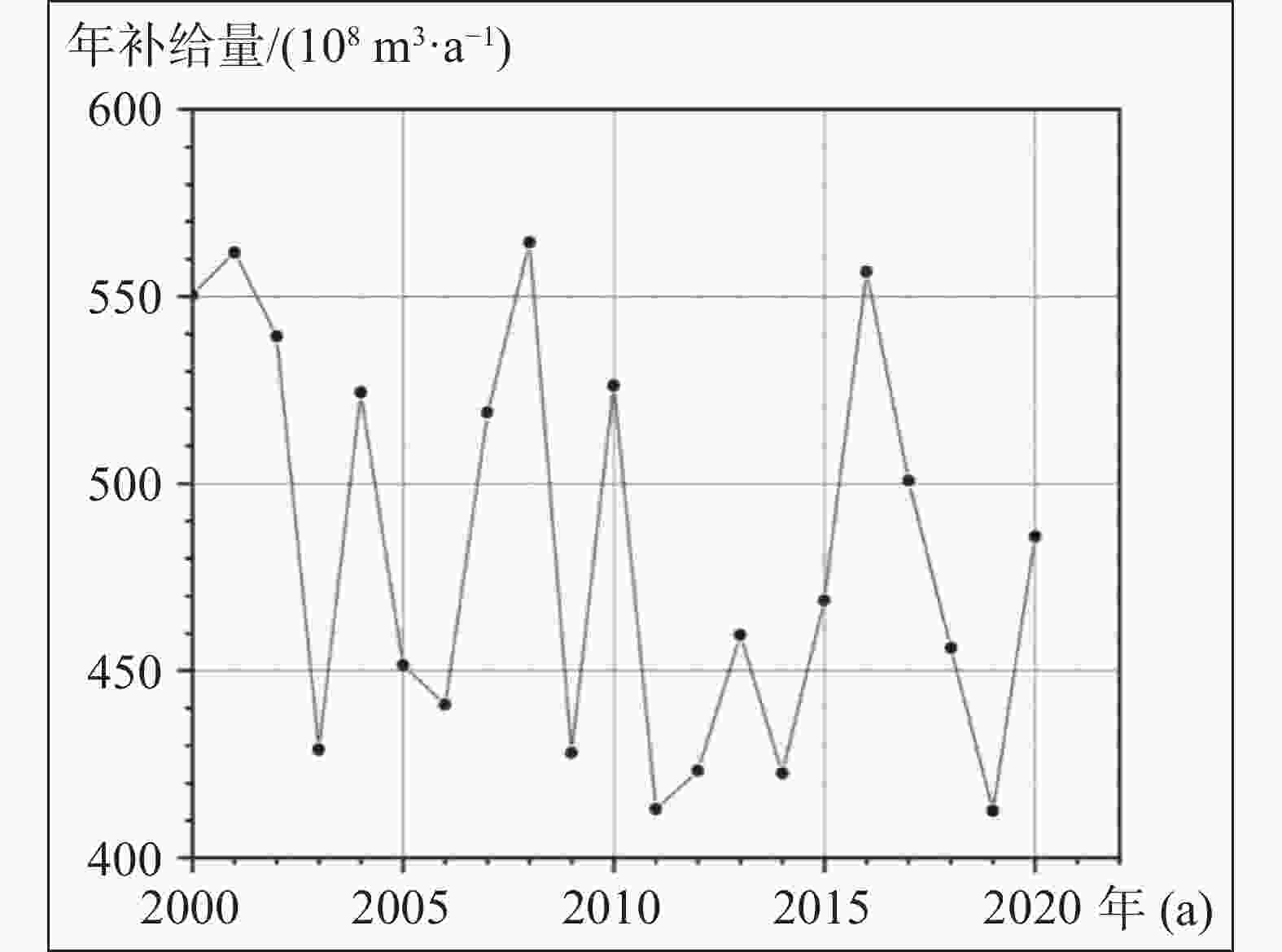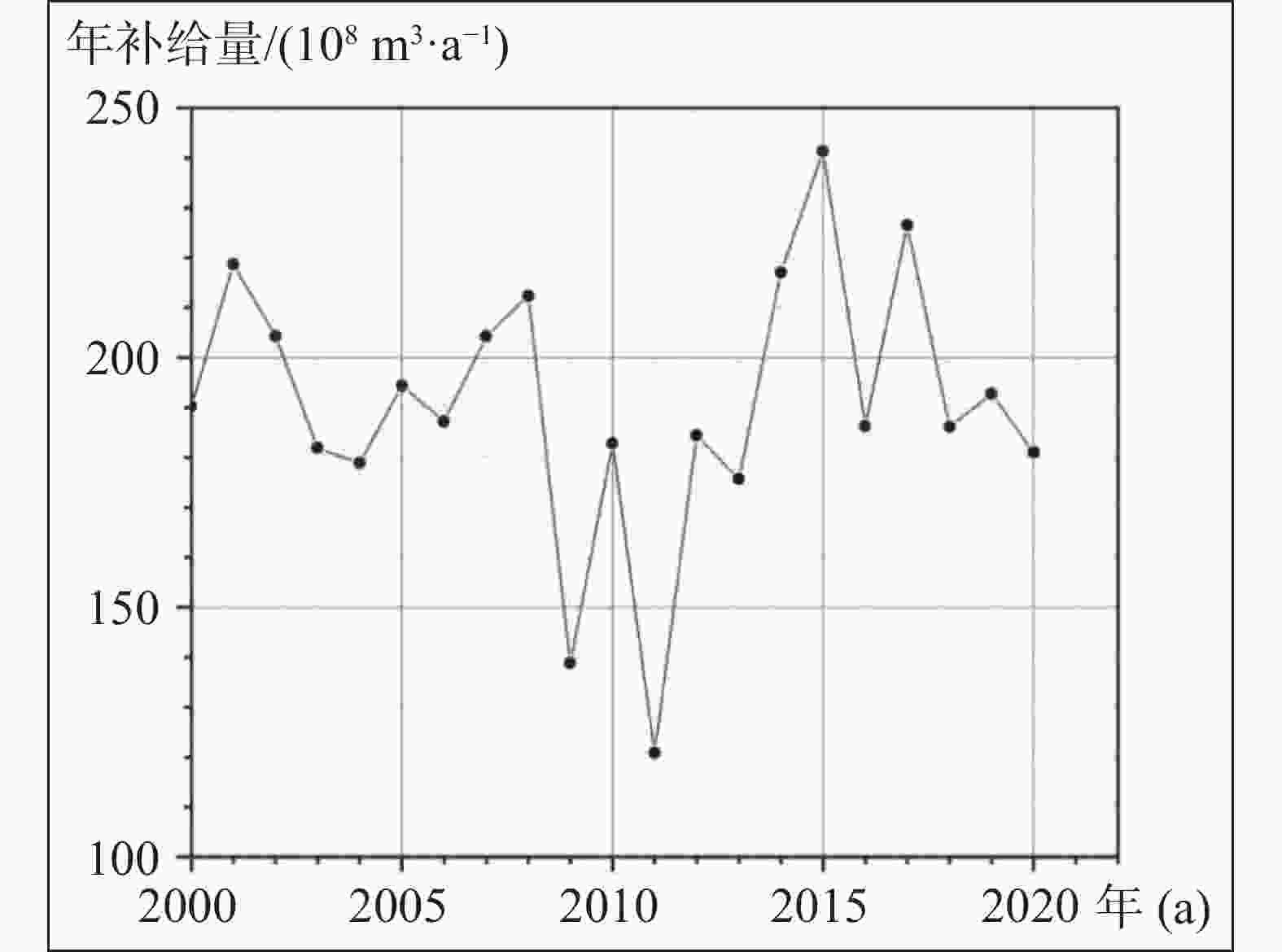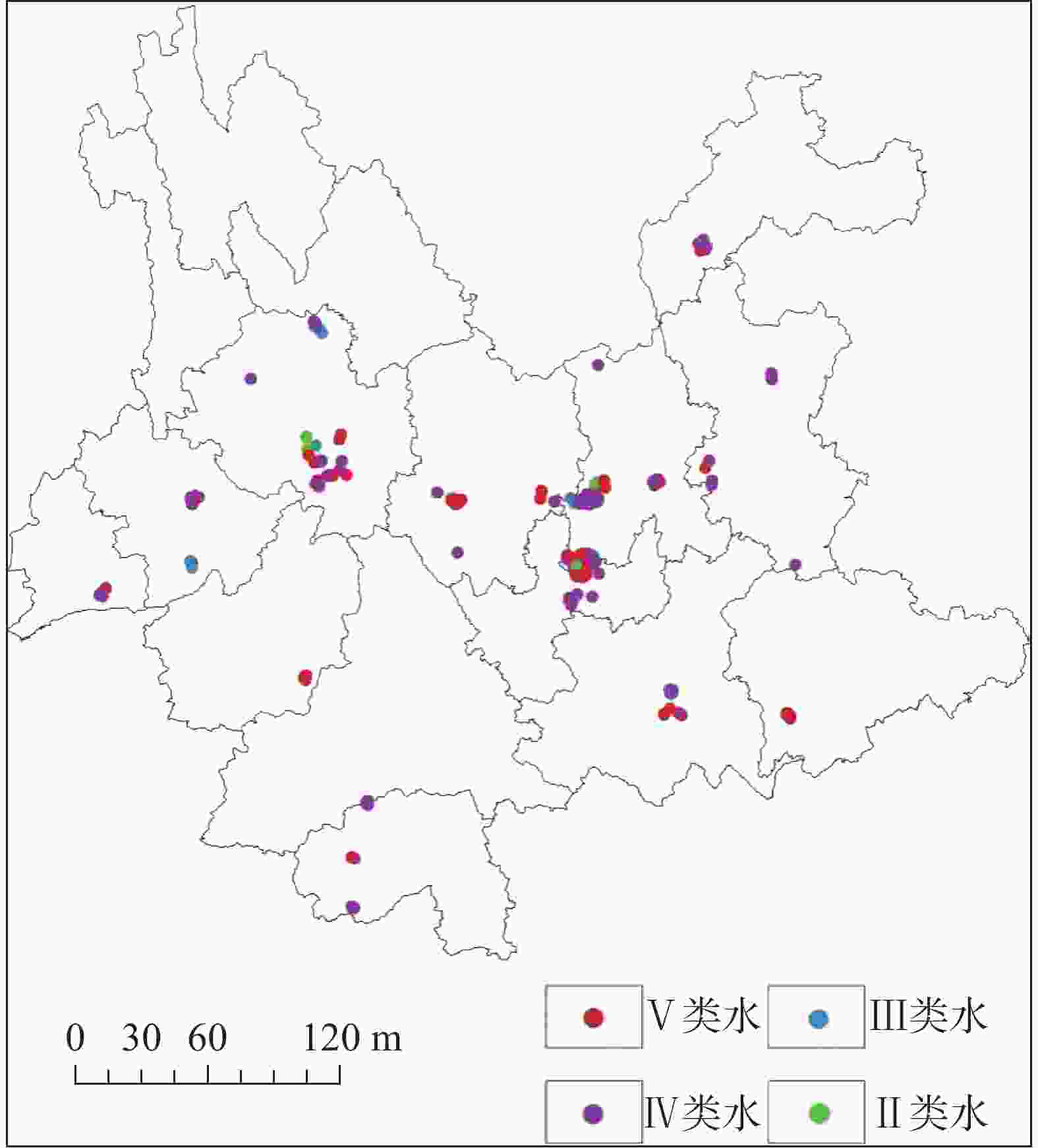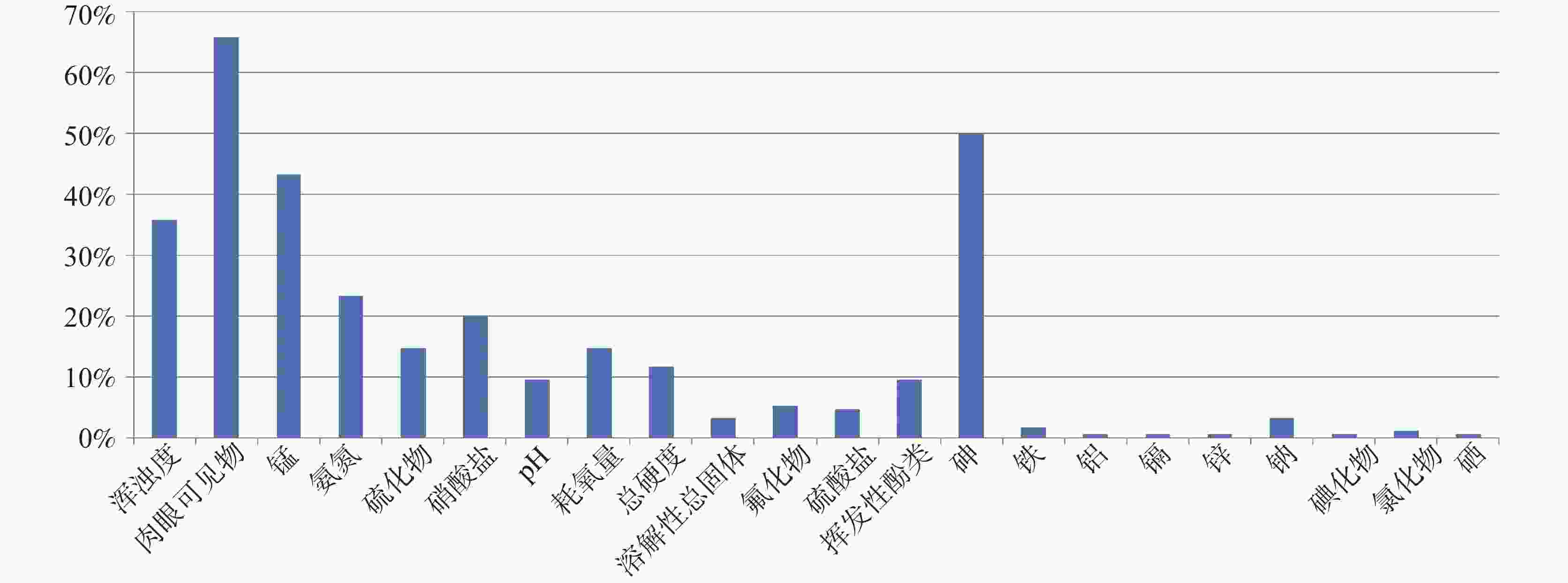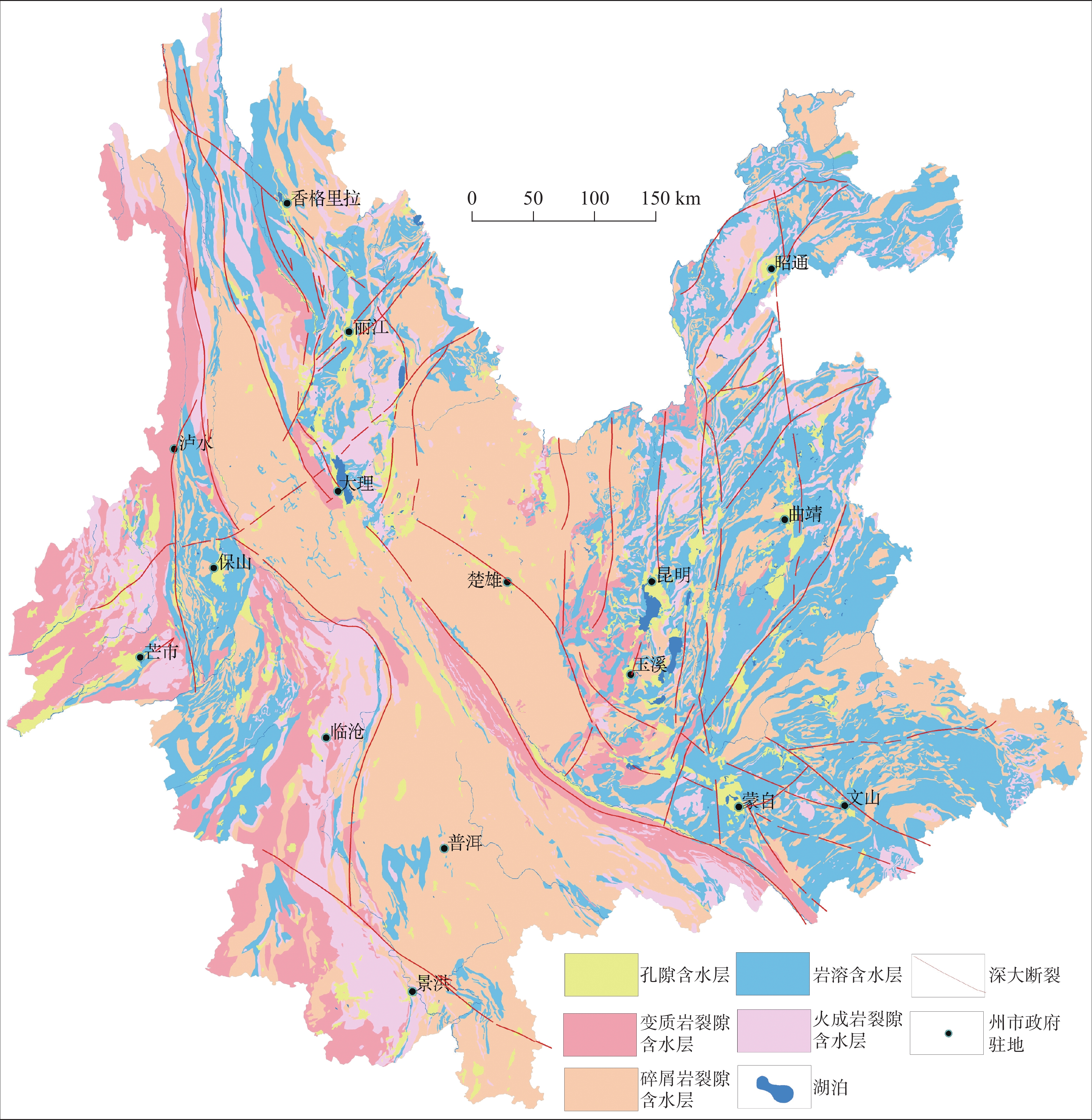Analysis of a new round of groundwater resource evaluation in Yunnan Province
-
摘要: 在系统研究云南省水文地质条件的基础上,将云南省地下水系统划分为21个四级流域系统,41个五级评价单元。文章论述了地下水资源的评价方法、参数确定,并展示了最终评价成果。2000-2020年多年平均地下水资源补给量为854.66亿m3·a−1,多年平均地下水径流资源量629.16亿m3·a−1,多年平均地下水径流资源量占地下水资源补给量的73.62%。对223个水质监测点检测结果评价分析显示:无Ⅰ类水;Ⅱ类水9个,占4%;Ⅲ类水24个,占10.76%;Ⅳ类水112个,占50.22%;Ⅴ类水78个,占34.98%。受污染的地下水类型多为孔隙水,一般属轻度或中等污染,少部分地区属重污染;基岩裂隙水,污染程度轻微。主要污染区分布于经济发达、人口密集的城市,如昆明、曲靖、玉溪、开远、楚雄、大理等地。Abstract:
Yunnan Province is located in the eastern region of the Qinghai-Tibet Plateau and the western area of the Yunnan-Guizhou Plateau. This province is characterized by mountainous plateau topography and is abundant in water resources. Groundwater resources hold great potential for development and utilization, but there is a critical issue regarding their uneven spatial distribution. Therefore, it is imperative to accurately investigate and evaluate the groundwater resources in Yunnan Province. Based on the systematic study of hydrogeological conditions in this province, its groundwater system is divided into 21 four-level basin systems and 41 five-level units for groundwater resource evaluation. In this paper, we systematically discuss the evaluation method and parameter determination for groundwater resources, and summarize and present the final evaluation results. In this evaluation, we utilized long-term rainfall data spanning from 2000 to 2020, along with the permeability coefficient and runoff modulus obtained from 1∶50,000 hydrogeological surveys conducted in Zhaotong, Yuanmou, Binchuan, Qujing, Yuxi, and other basins since 1960. Additionally, we incorporated data from the 1∶50,000 hydrogeological surveys of key karst areas in Yunnan, as well as the 1∶50,000 hydrogeological survey report of this province. We used the monitoring data from meteorological and hydrological stations to adjust the parameters of each evaluation zone in order to assess the groundwater resources in Yunnan Province. It is concluded that the average annual recharge of groundwater resources from 2000 to 2020 was 85.466 billion m3·a−1. The average annual groundwater runoff resources was 62.916 billion m3·a−1, accounting for 73.62% of the groundwater resource supply. Among them, the average annual groundwater resource supply in the Yangtze River Basin from 2000 to 2020 was 18.131 billion m3·a−1, while the average annual groundwater runoff resources during the same period was 13.942 billion m3·a−1. In contrast, the average annual groundwater resource supply in the river basins of Southwest China from 2000 to 2020 was 48.258 billion m3·a−1, with average annual groundwater runoff resources amounting to 34.106 billion m3·a−1. Besides, the average annual recharge of groundwater resources in the Pearl River Basin from 2000 to 2020 was 190.77 billion m3·a−1, and the average annual groundwater runoff resources was 148.68 billion m3·a−1. In the past 21 years, the groundwater resource supply in the Yangtze River Basin, the river basins of Southwest China, and the Pearl River Basin exhibited significant fluctuations, with the lowest supply occurring in 2011. The highest groundwater resource supply in the Yangtze River Basin was recorded in 2016. The Pearl River Basin experienced its peak supply in 2015, and the river basins of Southwest China had the highest supply in 2008. The data presented not only highlights the disparities in groundwater resources across various basins in Yunnan Province, but also serves as a crucial foundation for regional water resource management and planning. In terms of groundwater quality, the results from 223 water quality monitoring points in 2021 indicate that there were no Class I water samples detected; Class II water was found at 9 points, accounting for 4% of the total; Class III water was detected at 24 points, accounting for 10.76%; Class IV water was identified at 112 points, making up 50.22%; and Class V water was present at 78 points, which accounted for 34.98%. The types of contaminated groundwater primarily included pore water, which typically exhibited mild to moderate levels of pollution. In contrast, only a few areas were heavily polluted. Additionally, bedrock fissure water was present, but its degree of pollution was generally slight. Most of the pollutants were NH4+, F−, Fe, Mn, volatile phenols, Hg, COD, etc. The analysis of the factors influencing the quality of Class IV and Class V groundwater indicated that the most significant contributor to water quality exceeding permitted levels was the visible matter, followed by volatile phenols and manganese. In addition to the sensory index, the most influential factor was volatile phenols, followed by manganese and ammonia nitrogen. The main areas of pollution were concentrated in economically developed and densely populated cities, such as Kunming, Qujing, Yuxi, Kaiyuan, Chuxiong, Dali, and other places. In summary, although the groundwater resources in Yunnan Province are abundant, the water quality problem cannot be ignored. In the future, the protection and management of groundwater resources should be strengthened, especially in the areas with rapid economic development. The sustainable utilization of groundwater resources should be ensured by implementing stricter environmental protection policies, strengthening the monitoring and control of pollution sources, promoting water-saving technologies, and raising public awareness of environmental protection. -
Key words:
- groundwater resources /
- evaluation method /
- calculation parameter /
- hydroecology /
- the Yunnan plateau
-
表 1 评价参数取值表
Table 1. Values of evaluation parameters
含水
类型地层
代号富水性划分指标 地下水径
流模数
/L∙s−1·km−2地下水径流
模数平均值
/L∙s−1·km−2泉/L∙s−1 地下河出口/L∙s−1 流 量 平均流量 流 量 平均流量 裸露型
岩溶水含
水岩组较纯灰岩裂
隙溶洞水P2q-m 0.01~864.86 3.42 40.53~ 6500.00 945.09 4.3~22.15 11.78 Є1q 0.10~2.20 0.87 135.00 135.00 6.67~8.50 7.12 不纯灰岩溶
洞裂隙水S1sh 0.01~2.97 0.56 2.36~5.21 4.32 T2g2 0.10~60.98 2.65 14.21~ 5490.00 1455.00 4.58~5.36 4.98 T1-2j 0.05~201.00 4.87 6.73~210.00 62.95 3.00~19.06 8.87 O3j-w 0.02~50.49 0.45 1.26~4.62 3.43 O2-3sh-b 0.01~30.52 0.09 0.14~0.82 0.54 T2g1 0.01~68.35 1.23 2.03~2.56 2.27 T1y2 0.01~150.56 2.11 28.00~240.90 100.30 3.07~3.45 白云岩孔
洞裂隙水O1t-h 0.20~30.20 1.16 5.26 Є2-3l 0.01~68.61 1.97 510.20 510.20 3.88~5.30 4.85 Є2g-s 0.01~8.87 1.15 3.40~4.33 非可溶岩孔
隙裂隙水
含水岩组碎屑岩岩
孔裂隙水J3s 0.01~0.25 0.11 0.52~0.92 J2s 0.01~0.51 0.13 1.32~1.43 J2x 0.05~0.31 0.17 0.83~0.94 J1z 0.005~0.44 0.09 0.85~0.96 J1x 0.52~0.92 T3s 0.10 0.10 0.83 P3lt-c 0.01~3.40 0.48 3.07~3.86 P2ls 0.10~1.83 0.42 2.12~2.85 S1h 0.80 0.80 0.92 S1l 0.513 0.513 0.86 O1-2m 0.01~10.07 0.85 3.03~3.68 Є1j 0.31 0.31 0.90 玄武岩(风化)裂隙水 P3β 0.01~15.60 0.33 0.32 表 2 云南省水资源评价结果对比表
Table 2. Comparison of water resource evaluation results in Yunnan Province
评价时间 地下水补给量/
亿m3∙a−1地下水资源量/亿m3∙a−1 径流模数法 水文分割法 2000-2020年(多年平均) 752.440 742.740 761.610 2000-2020年(多年平均) 线下计算 854.655 629.158 栅格分析 872.737 632.102 表 3 2021年度地下水质量评价统计表
Table 3. Statistics of comprehensive evaluation of groundwater quality in 2021
地下水资源分区 含水介质类型 统计监测
点数/个最高单项指标类别 Ⅰ Ⅱ Ⅲ Ⅳ Ⅴ 金沙江 岩溶水 74 7 15 35 17 孔隙水 31 1 14 16 裂隙水 26 1 15 10 澜沧江—红河 岩溶水 1 1 孔隙水 18 2 2 9 5 裂隙水 19 9 10 怒江—伊洛瓦底江 岩溶水 4 3 1 孔隙水 13 2 5 6 裂隙水 4 2 2 珠江中上游 岩溶水 12 1 5 6 孔隙水 10 1 7 2 裂隙水 11 8 3 合计 223 9 24 112 78 表 4 珠江流域水资源计算验证表
Table 4. Verification of water resource calculation in the Pearl River Basin
项目 水资源量/万m3∙a−1 对A比值 对B比值 对C比值 对D比值 A.珠江流域地下水资源量(基流分割法) 1870704634 1 329.55% 893.02% 346.46% B.南盘江2020~2021基流量下限 567648000 30.34% 1 270.98% 105.13% C.南盘江枯季径流量 209480324 11.20% 36.90% 1 38.80% D.径流量法珠江枯季资源量 539949400 28.86% 95.12% 257.76% 1 -
[1] 王宇, 张贵, 张华, 康晓波, 彭淑惠, 王波, 王劲, 周翠琼. 云南省岩溶水文地质环境地质调查与研究[M]. 北京:质出版社, 2018. [2] 张华, 王宇, 张贵. 云南重点岩溶流域水文地质及环境地质调查成果评析[J]. 云南地质, 2014, 33(2):259-263. doi: 10.3969/j.issn.1004-1885.2014.02.021ZHANG Hua, WANG Yu, ZHANG Gui. An analysis and assessment of hydrogeological and environment geological survey in key karst drainage area in Yunnan[J]. Yunnan Geology, 2014, 33(2): 259-263. doi: 10.3969/j.issn.1004-1885.2014.02.021 [3] 王宇. 云南省地下水资源潜力评价现状与问题分析[J]. 中国岩溶, 2020, 39(2):137-146. doi: 10.11932/karst20200201WANG Yu. Evaluation status and problems of groundwater resource potential in Yunnan Province[J]. Carsologica Sinica, 2020, 39(2): 137-146. doi: 10.11932/karst20200201 [4] 卢丽, 樊连杰, 裴丽欣, 邹胜章, 林永生, 邓日欣, 王喆. 海南岛地下水资源状况及其环境地质问题[J]. 中国地质, 2022, 51(2):499-510.LU Li, FAN Lianjie, PEI Lixin, ZOU Shengzhang, LIN Yongsheng, DENG Rixin, WANG Zhe. Groundwater resources and environmental geologic problems on Hainan Island[J]. Geology in China, 2022, 51(2): 499-510. [5] 孙超, 王昕洲, 叶莹莹, 刘琼, 曹颐, 韩冲, 王轶. 河北省地下水资源承载能力评价及预警方法研究[J]. 水文地质工程地质, 2022, 49(6):55-63.SUN Chao, WANG Xinzhou, YE Yingying, LIU Qiong, CAO Yi, HAN Chong, WANG Yi. Research on evaluation and early warning of groundwater resources carrying capacity in Hebei Province[J]. Hydrogeology & Engineering Geology, 2022, 49(6): 55-63. [6] 康小兵, 罗声, 许模, 刘宏. 华蓥山中段地区地下水资源量评价[J]. 中国岩溶, 2018, 37(4):527-534. doi: 10.11932/karst20180406KANG Xiaobing, LUO Sheng, XU Mo, LIU Hong. Evaluation of groundwater resource loss in middle regions of Huaying mountain[J]. Carsologica Sinica, 2018, 37(4): 527-534. doi: 10.11932/karst20180406 [7] 龚建师, 王赫生, 李亮, 周锴锷, 叶永红, 朱春芳, 徐乃政, 陶小虎, 檀梦皎, 束龙仓, 赵贵章. 淮河流域地下水资源概况及开发潜力[J]. 中国地质, 2021, 48(4): 1052-1061.GONG Jianshi, WANG Hesheng, LI Liang, ZHOU Kaie, YE Yonghong, ZHU Chunfang, XU Naizheng, TAO Xiaohu, TAN Mengjiao, SHU Longcang, ZHAO Guizhang. Groundwater resources and development potential in Huaihe river basin[J]. Geology in China, 2021, 48(4): 1052-1061. [8] 韩双宝, 李甫成, 王赛, 李海学, 袁磊, 刘景涛, 申豪勇, 张学庆, 李长青, 吴玺, 马涛, 魏世博, 赵敏敏. 黄河流域地下水资源状况及其生态环境问题[J]. 中国地质, 2021, 48(4):1001-1019.HAN Shuangbao, LI Fucheng, WANG Sai, LI Haixue, YUAN Lei, LIU Jingtao, SHEN Haoyong, ZHANG Xueqing, LI Changqing, WU Xi, MA Tao, WEI Shibo, ZHAO Minmin. Groundwater resource and eco-environmental problem of the Yellow River Basin[J]. Geology in China, 2021, 48(4): 1001-1019. [9] 彭红明, 王占巍, 罗银飞, 袁有靖, 王万平. 基于地下水数值模拟的布哈河流域地下水可开采资源量评价[J]. 现代地质, 2022, 37(4):943-953.PENG Hongming, WANG Zhanwei, LUO Yinfei, YUAN Youjing, WANG Wanping. Evaluation of exploitable groundwater resources in the Buha river basin based on groundwater numerical simulation[J]. Geoscience, 2022, 37(4): 943-953. [10] 吴昊, 张兴奇, 都金康. 基于水足迹理论与LMDI 模型的贵州省水资源利用评价[J]. 中国岩溶, 2019, 38(5):696-703. doi: 10.11932/karst20190505WU Hao, ZHANG Xingqi, DU Jinkang. Evaluation of water resources utilization in Guizhou Province based on water footprint theory and LMDI model[J]. Carsologica Sinica, 2019, 38(5): 696-703. doi: 10.11932/karst20190505 [11] 王宇, 彭淑慧. 云南省岩溶水赋存特征[J]. 中国岩溶, 2011, 30(3):253-259. doi: 10.3969/j.issn.1001-4810.2011.03.003WANG Yu, PENG Shuhui. Distribution features of karst water in Yunnan[J]. Carsologica Sinica, 2011, 30(3): 253-259. doi: 10.3969/j.issn.1001-4810.2011.03.003 [12] 高瑜, 张华, 杨帆, 武贵华, 武红梅. 云南省地下水资源评价成果报告[R]. 昆明:云南省地质环境监测院, 2023.GAO Yu, ZHANG Hua, YANG Fan, WU Guihua, WU Hongmei. Report on the evaluation results of groundwater resources in Yunnan Province[R]. Kunming: Yunnan Institute of Geo-Environment Monitoring, 2023. [13] 胡萌, 盛英武. 青岛年降水量和水资源量变化特征研究[J]. 水文, 2022, 42(1):103-108.HU Meng, SHENG Yingwu. Study on variation characteristics of precipitation and water resources in Qingdao[J]. Journal of China Hydrology, 2022, 42(1): 103-108. [14] 董亚军, 吴扬, 冯菊霞. 西安市黑河灌区水文地质条件及地下水资源量计算方法探讨[J]. 地下水, 2022, 44(5):65-68. [15] 党学亚, 张俊, 常亮, 顾小凡. 西北地区水文地质调查与水资源安全[J]. 西北地质, 2022, 55(3):81-94.DANG Xueya, ZHANG Jun, CHANG Liang, GU Xiaofan. Hydrogeological survey and water resources security in Northwest China[J]. Northwestern Geology, 2022, 55(3): 81-94. [16] 魏良帅, 郭蕾蕾, 黄安邦, 舒勤峰. 西南缺水区地下水水量、水质空间分异特征及成因分析:以乌蒙山片区金沙江干流绥江—屏山段为例[J]. 山地学报, 2021, 39(5):658-671.WEI Liangshuai, GUO Leilei, HUANG Anbang, SHU Qinfeng. Spatial differentiation of groundwater storage, quality and their genesis in water-deficient areas of Southwest China: A case study of the Suijiang-Pingshan section of the Jinshajinag river in the Wumengshan mountain areas, China[J]. Mountain Research, 2021, 39(5): 658-671. [17] 杨杨, 赵良杰, 潘晓东, 夏日元, 曹建文. 西南岩溶山区地下水资源评价方法对比研究:以寨底地下河流域为例[J]. 中国岩溶, 2022, 41(5):111-123.YANG Yang, ZHAO Liangjie, PAN Xiaodong, XIA Riyuan, CAO Jianwen. Comparative study on evaluation methods of groundwater resources in karst area of Southwest China: Taking Zhaidi underground river basin as an example[J]. Carsologica Sinica, 2022, 41(5): 111-123. [18] 王宇. 岩溶区地表水与地下水资源及环境统一评价的流域边界划分研究[J]. 中国岩溶, 2019, 38(4):823-830. doi: 10.11932/karst2019y08WANG Yu. Study on watershed boundary division for unified evaluation of surface water and groundwater resources and environment in karst areas[J]. Carsologica Sinica, 2019, 38(4): 823-830. doi: 10.11932/karst2019y08 [19] 贾建伟, 王栋, 何康洁, 刘昕. 长江流域地下水资源量分布特征及开采潜力分析[J]. 人民长江, 2021, 52(9):107-112.JIA Jianwei, WANG Dong, HE Kangjie, LIU Xin. Distribution characteristics and exploitation potentiality of groundwater resources in Changjiang River Basin[J]. Yangtze River, 2021, 52(9): 107-112. [20] 黄长生, 周耘, 张胜男, 王节涛, 刘凤梅, 龚冲, 易秤云, 李龙, 周宏, 魏良帅, 潘晓东, 邵长生, 黎义勇, 韩文静, 尹志彬, 李晓哲. 长江流域地下水资源特征与开发利用现状[J]. 中国地质, 2021, 48(4):979-1000.HUANG Changsheng, ZHOU Yun, ZHANG Shengnan, WANG Jietao, LIU Fengmei, GONG Chong, YI Chengyun, LI Long, ZHOU Hong, WEI Liangshuai, PAN Xiaodong, SHAO Changsheng, LI Yiyong, HAN Wenjing, YIN Zhibin, LI Xiaozhe. Groundwater resources in the Yangtze River Basin and its current development and utilization[J]. Geology in China, 2021, 48(4): 979-1000. [21] 高瑜, 张华, 康晓莉, 周俊蓉, 武红梅, 刘海峰, 叶咸. 云南省主要盆地地下水水质监测与变化趋势分析[J]. 中国岩溶, 2022, 41(4):542-552. doi: 10.11932/karst20220404GAO Yu, ZHANG Hua, KANG Xiaoli, ZHOU Junrong, WU Hongmei, LIU Haifeng, YE Xian. Trend analysis of groundwater quality in major basins of Yunnan Province[J]. Carsologica Sinica, 2022, 41(4): 542-552. doi: 10.11932/karst20220404 [22] 赵良杰, 杨杨, 曹建文, 夏日元, 王喆, 栾崧, 林玉山. 珠江流域地下水资源评价及问题分析[J]. 中国地质, 2021, 48(4):1020-1031.ZHAO Liangjie, YANG Yang, CAO Jianwen, XIA Riyuan, WANG Zhe, LUAN Song, LIN Yushan. Groundwater resources evaluation and problem analysis in Pearl River Basin[J]. Geology in China, 2021, 48(4): 1020-1031. -




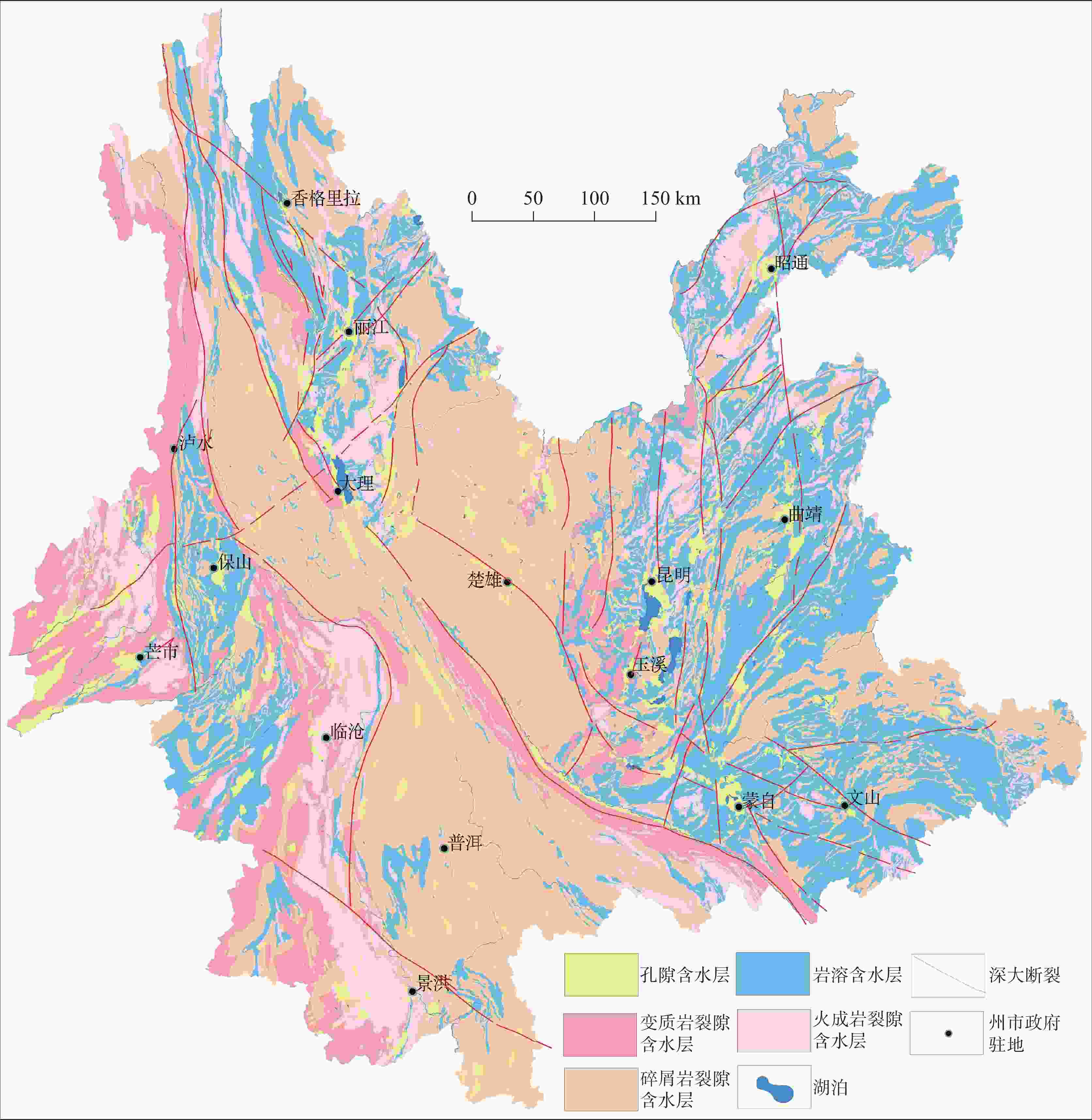
 下载:
下载:
